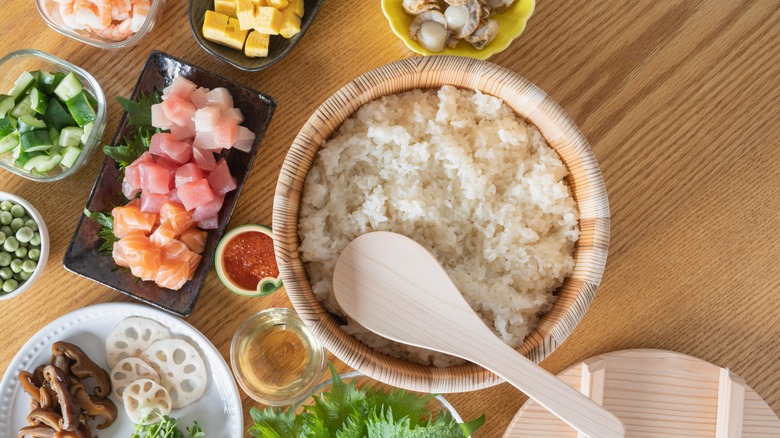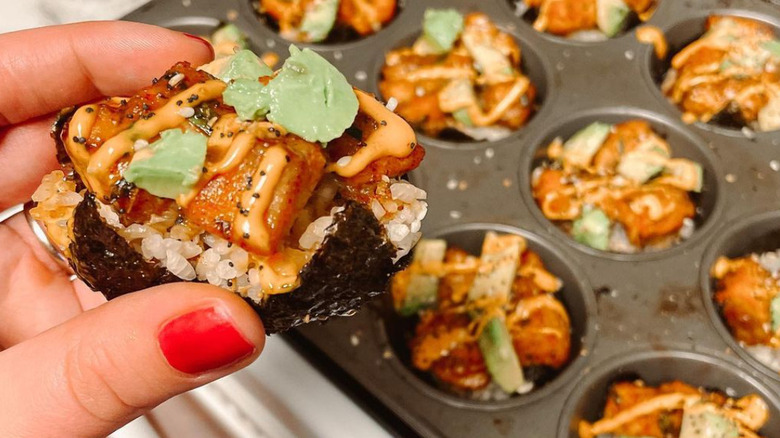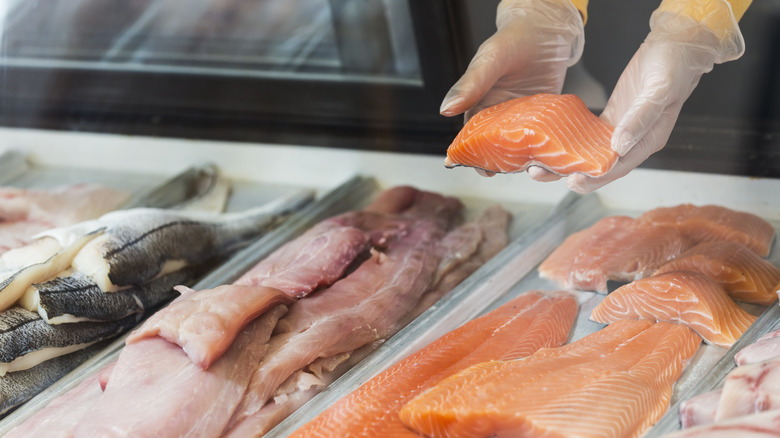The Muffin Tin Hack For Quick And Easy Sushi Bites
If you've ever tried to assemble homemade sushi, you know how difficult it can be to create neatly packed rolls that hold all your ingredients and don't fall apart as you eat. For an easy and fun alternative to making sushi, try using a muffin tin: Simply press the rice into its cups and load your preferred ingredients like salmon, ahi tuna, cucumber, and avocado. This creative use for your muffin tin has gone viral for good reason — it's a simple yet effective way to make super tasty sushi at home, and you can easily customize the recipe to suit multiple likings. Why not save the rolling for the sushi chefs and make delicious sushi cups to enjoy and share with friends as a fresh and creative appetizer?
Everyone has their preferences when it comes to eating raw or cooked sushi. One of the best parts of making sushi bites in a muffin tin is that you can choose to simply load your ingredients and eat them raw or bake them in the oven for a warm, crispier bite. So, if you're serving this deconstructed sushi appetizer for your next dinner party, satisfy all your guests' taste buds by making plenty of mix-and-match options for them to choose from.
Tips for making sushi bites
Sushi muffins are relatively easy to make, but there are a few helpful tips for ensuring the process runs smoothly and results in a mouthwatering snack you'll want to make again and again. For one, before you fill your muffin cups with rice and other ingredients, spray the pan with cooking spray to prevent the sushi bites from sticking to the tin. This way, they'll remain a whole piece instead of a jumbled mess that looks more like a sushi salad than a sushi bite.
Another important step for ensuring your sushi doesn't fall apart is using either parchment paper or nori (dried seaweed) cut into small squares to line the muffin cups and provide a wrapper for your ingredients. Typically, sushi bites with raw fish like ahi tuna or salmon are made with parchment paper (after being refrigerated, the bites are removed from the paper and eaten cold). On the other hand, baked sushi muffins (often containing salmon) are usually made with nori for an edible wrapper that crisps up nicely in the oven.
Depending on your preferences, there are many ways to make super tasty sushi bites. Some ideas include marinating your tuna or salmon in a mixture that contains soy sauce, sesame oil, and vinegar, using bread crumbs to give it some crunch, drizzling spicy mayo on top, adding sesame seeds, and a dab of wasabi for an extra kick to your bite.
How to buy sushi-grade fish
When making sushi at home, people often wonder what type of fish is safe to consume raw and the best places to buy fish. When you're looking for the best fish for your sushi, look for sushi-grade salmon, tuna, or other fish. Sushi-grade is a label sellers use to indicate that the fish is very high quality and can typically be eaten raw without risk of food poisoning. According to Good Housekeeping, Kate Koo — head sushi chef and owner of Zilla Sake in Portland — offers some advice to people looking to buy sushi-grade fish: "Do not go to a regular grocery store and grab any random piece of salmon from the display and eat that raw, because there is a difference."
Koo advises going to a fish market (easier to do if you live near the coast), an Asian market, or a high-end grocery store instead. John Burrows, Seafood Technical Director at the Alaska Seafood Marketing Institute, says, "The best way is to ask about the quality itself to the fishmonger or fisherman, specifically about how the fish has been stored and transported." According to Burrows, temperature control is the most important indicator of fish quality — fish should be frozen to retain freshness and flavor. Color and smell are also indicators of fish quality. If your salmon is a dull or gray color and has a strong fishy smell, you don't want to eat it raw or cooked.


